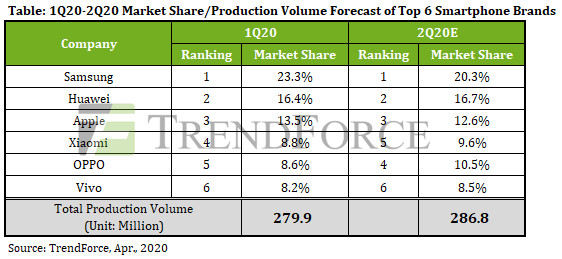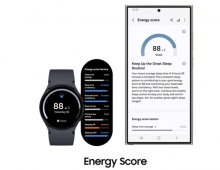
Smartphone Production Expected to Drop by 16.5% YoY in 2Q20
TrendForce has revised down its forecast of yearly smartphone production volume to 1.24 billion units, an 11.3% decrease YoY, given weakening end-product demand.
According to the latest investigations by TrendForce, the global spread of COVID-19 in 2020 has brought about the greatest magnitude of declines in the smartphone market in recent years. Global smartphone production for 1Q20 fell by 10% YoY to around 280 million units, the lowest in five years, due to pandemic-induced disruptions across the supply chain, such as delayed work resumption and labor/material shortages, which caused low factory capacity utilization rates.
Turning to 2Q20, there are now improvements to both the supply chain and the work resumption statuses of manufacturing and assembly lines, but the pandemic is now making its effects felt on the demand side of the smartphone market by tanking major economies worldwide. Global production for 2Q20 is now estimated to register another YoY drop of 16.5% to 287 million units, the largest decline on record for a given quarter. TrendForce forecasts total yearly production volume of 1.24 billion units, an 11.3% decrease YoY.
1Q20 leader Samsung will be experiencing constrained growth this year even without the emergence of COVID-19. In addition to the saturation of the market, Chinese brands are exerting continuous pressure on Samsung’s presence in the Southeast Asian and Indian markets by the day. Most of Samsung’s smartphone assembly lines are located in Vietnam and India, and the company possesses about only 2% of the market share for smartphones in China. Its production was thus not significantly affected by issues related to the disease during the initial phase of the outbreak in China. Nevertheless, the rapid spread of the disease across North America and Europe in the later part of 1Q20 compelled Samsung to lower its device output even as its factories were running as usual. The brand’s production volume for 1Q20 came to 65.3 million units, showing a YoY drop of 9.9%. Moving into 2Q20, India’s smartphone assembly lines have been suspended since late March due to the imposition of a national lockdown. Furthermore, the global economy has gone into a recession. TrendForce thus estimates that Samsung’s smartphone production for 2Q20 will fall by 10.7% QoQ to 58.3 million units.
Huawei, which took second place in the production ranking for 1Q20, was able to have its device assembly lines resume work soon after the Lunar New Year holiday. This brand has seen a steep decline in overseas sales due to its new devices being excluded from Google Mobile Services. Nevertheless, demand from China, which is its primary market, has started to recover. With the support of domestic demand, Huawei’s smartphone production for 1Q20 came to 46 million units, in line with TrendForce’s earlier projection. If China’s economy continues to improve, Huawei’s production for 2Q20 may register a QoQ growth and reach approximately 48 million units. Huawei is sticking with its plan of making a push for its 5G smartphones this year, but 4G models will still account for most of its 1H20 smartphone output, and Huawei is also holding a significant inventory of 4G models. Therefore, Huawei’s greatest challenge at the present is to simultaneously develop an effective campaign to promote the latest 5G smartphones and sell off the existing stock of 4G smartphones.
Prior to the onset of COVID-19, TrendForce had originally expected Apple to once again reach yearly production of 200 million units, owing to the release of five new models this year and the phasing out of the popular iPhone 6s series by the seasonal smartphone replacement cycle. However, Apple fell victim to the influence of the coronavirus pandemic, resulting in the reduced production of its iPhone lineups this year. In terms of 1Q20 performance, iPhone production fell by 8.7% YoY, reaching 37.9 million units, due to labor and material shortages following the post-Lunar New Year work resumption, in turn ranking Apple in the third place. As the company releases the new iPhone SE with a consumer-friendly price tag in 2Q20, quarterly iPhone production is expected to stay relatively close to 1Q20 figures, reaching 36 million units. Apple is still planning to release four new 5G handsets in 2H20, but whether the pandemic’s influence will weaken the demand for iPhones going forward remains a noteworthy concern, since iPhones sell at a relatively high retail price, and the iPhone’s primary sales regions are the European and U.S. markets, which are in the midst of dealing with COVID-19.

Overseas markets account for over 70% of fourth-ranked Xiaomi’s sales. As these markets were unaffected by the Lunar New Year, Xiaomi rapidly expanded its production capacity, following its domestic work resumption, to meet the demand from overseas channels. But Xiaomi also had to contend with industry-wide issues of labor and material shortages, resulting in lower than expected capacity utilization of its production lines. The company registered 1Q20 production of 24.5 million units, which kept flat with 1Q19 figures. TrendForce expects the 2Q20 acceleration of COVID-19 in India and Indonesia, both of which are major sales regions for Xiaomi, to impact their quarterly smartphone demand and lead to a 10.7% decrease YoY in Xiaomi’s 2Q20 production, totaling 27.5 million units; the pandemic is projected to have a greater impact on Xiaomi relative to other Chinese brands that rely primarily on domestic sales. In response, Xiaomi will aim to gain a competitive advantage by pricing its 5G handsets for low gross margins, in an effort to capture a greater share of the Chinese market, in turn making up for the shortfall in overseas sales.
OPPO (including OnePlus, OPPO, and Realme) and Vivo, ranked fifth and sixth respectively, benefitted from increased overseas orders, but their capacity utilization rates have been sluggish following post-Lunar New Year work resumption. OPPO posted 1Q20 production volume of 24 million units, a 10.4% decrease YoY. On the other hand, Vivo had traditionally maintained conservative production plans during past first quarters, meaning the base period for YoY comparisons with 1Q20 is relatively low; Vivo’s production volume in 1Q20 grew by 5.5% YoY, reaching 23 million units, placing it as the only smartphone brand in the top six exhibiting a YoY growth, against the overall trend of declines. Looking to 2Q20, TrendForce has lowered its production forecast for the quarter in light of national lockdowns in Southeast Asia and India starting in March: 30 million and 24.5 million units for OPPO and Vivo, respectively, with each brand undergoing more than 14% decrease YoY.
The pandemic’s impact prompted governments to prioritize disease prevention and stabilization; furthermore, consumers generally have a speculative attitude towards purchasing 5G handsets. These two factors diminished the smartphone market’s momentum of transitioning from 4G into 5G in 1H20. In 2H20, if the Chinese government stays the course in commercializing 5G, and mid-range 5G chips are successfully supplied to the market, the Chinese smartphone market will then see increased incentive to transition into 5G, while also resulting in 5G handsets’ consumer-friendly retail prices. At the moment, as brands fight over 5G market shares, the yearly forecast of 5G smartphone production volume remains around the 200 million unit mark, with a 16% penetration rate in the overall smartphone market. In particular, Chinese brands occupy over 60% of 5G smartphone market share, with the domestic Chinese market as their primary sales region. This means the penetration rate of 5G handsets in the overall smartphone market will depend heavily on feedbacks from the Chinese market. However, the penetration rate of 5G smartphones does not absolutely reflect the availability of 5G networks, which will depend on the construction of 5G base stations.





















